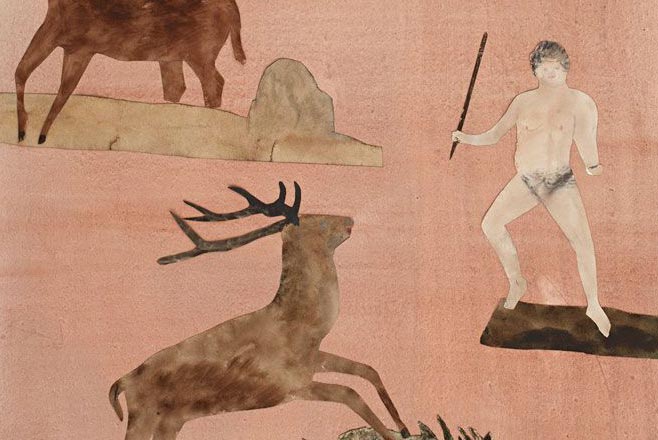Jockum Nordström’s paintings and collages consider the impact of tradition, and our sense of self within a wider community. The artist’s flatly abstracted and caricatured figures, animals, architecture and objects pit childlike wonder at the natural world against our contemporary way of living. The figures invite the viewer to take a closer look, changing as more attention is paid to the miniature details of their interactions.
Nordström uses a mishmash of techniques, shifting between various modes of representation. Faces appear to hover between expressions and styles, from the crude and cartoonish, to the graphic and illustrative or tight and classical. Scale and proportion also shift within the compositions; characters become as big as buildings and mountains, and ships, sea monsters and impossible landscapes are crammed into the page, as they might be in the uncontrollable creative imagination of a child.
Some compositions recall the Lascaux cave paintings or typical Canadian Inuit prints in their formal treatment of human and animals – stirring a sense of magical optimism. Yet in different compositions, scenes are neatly contained in detailed domestic spaces, rendered with a draftsman’s dedication to line and cross-hatched shading. Nordström’s approximations of interactions (or lack thereof) suggest caricatured advents of community from cavemen, to early settlers, to bureaucratic industrialism.
While his drawings cram as much into the frame as possible, Nordström’s collages harbour expanses of space. Figures gesture in cut-out poses, their bodies frozen in dance, mounted penetration, titillation or colonial gesticulation. Silhouettes of figures, trees, instruments, housing estates, insects, chairs and animals, incongruously pitched into their surroundings, absently negotiate their situations. Recalling the two dimensionality of a crude set design, elements hover without a solid ground to hold them down.
Figures frolic innocently – dancing, playing instruments, reaching out to animals – but are also stuck together in detached sexual positions which resemble poorly copied cartoons from smutty pulp fiction. These do not feel like illustrations of sexual desire but displays for the viewer to consume, before giggling about their static back-and-forth ‘intimacy’. The artist’s drawing and collage style is crudely liberated, preventing the images from becoming offensive. They are juxtaposed with characters postulating and pontificating in top hats and white wigs; role-players at odds in a shared place.
Nordström’s work revels in the pleasure associated with looking, exploring an image and allowing a narrative to unfold. The spaces in his landscapes feel precarious, as versions of characters and things are repeated across different compositions, like recurring dreams or reused bits of scenery from an amateur dramatics class. There is a sense of enjoyment to these landscapes, the result of Nordström’s vivid imagination and humour; but they also quietly point to the artist’s disquieted view of contemporary life.
‘Jockum Nordström: All I Have Learned and Forgotten Again’ is on at Camden Arts Centre until 29 September 2013.




